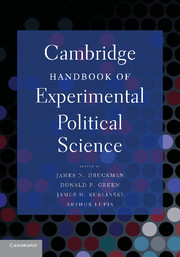Book contents
- Frontmatter
- Contents
- List of Tables
- List of Figures
- Contributors
- Acknowledgments
- INTRODUCTION
- PART I DESIGNING EXPERIMENTS
- PART II THE DEVELOPMENT OF EXPERIMENTS IN POLITICAL SCIENCE
- PART III DECISION MAKING
- 10 Attitude Change Experiments in Political Science
- 11 Conscious and Unconscious Information Processing with Implications for Experimental Political Science
- 12 Political Knowledge
- PART IV VOTE CHOICE, CANDIDATE EVALUATIONS, AND TURNOUT
- PART V INTERPERSONAL RELATIONS
- PART VI IDENTITY, ETHNICITY, AND POLITICS
- PART VII INSTITUTIONS AND BEHAVIOR
- PART VIII ELITE BARGAINING
- PART IX ADVANCED EXPERIMENTAL METHODS
- AFTERWORD
- Name Index
- Subject Index
- References
10 - Attitude Change Experiments in Political Science
Published online by Cambridge University Press: 05 June 2012
- Frontmatter
- Contents
- List of Tables
- List of Figures
- Contributors
- Acknowledgments
- INTRODUCTION
- PART I DESIGNING EXPERIMENTS
- PART II THE DEVELOPMENT OF EXPERIMENTS IN POLITICAL SCIENCE
- PART III DECISION MAKING
- 10 Attitude Change Experiments in Political Science
- 11 Conscious and Unconscious Information Processing with Implications for Experimental Political Science
- 12 Political Knowledge
- PART IV VOTE CHOICE, CANDIDATE EVALUATIONS, AND TURNOUT
- PART V INTERPERSONAL RELATIONS
- PART VI IDENTITY, ETHNICITY, AND POLITICS
- PART VII INSTITUTIONS AND BEHAVIOR
- PART VIII ELITE BARGAINING
- PART IX ADVANCED EXPERIMENTAL METHODS
- AFTERWORD
- Name Index
- Subject Index
- References
Summary
The importance of attitudes and the processes by which they are formed and changed is ubiquitous throughout political science. Perhaps the most obvious example is research exploring citizens' attitudes toward candidates, how these attitudes are influenced by political advertising and other persuasive messages, and how these attitudes influence decisions and behavior (see McGraw's chapter in this volume). Attitudes toward candidates are fundamental to the democratic process because they help voters make vote choices, perhaps the most basic way in which citizens can express their opinions and influence government (e.g., Rosenstone and Hansen 1993). Other key attitudes in the political domain include attitudes toward specific policies that also help voters make important decisions about voting, vote choice, and activism (e.g., Rosenstone and Hansen 1993). Attitudes toward institutions such as political parties and government entities also influence people's view of government. Finally, attitudes toward other groups in society (e.g., African Americans, women) may help determine support for specific policies (e.g., Transue 2007). Thus, attitudes play a central role in many of the democratic processes studied by political scientists reviewed in this volume (e.g., Gadarian and Lau; Hutchings; Lodge and Tabor; McGraw; Nelson; Wilson and Eckel).
- Type
- Chapter
- Information
- Cambridge Handbook of Experimental Political Science , pp. 141 - 154Publisher: Cambridge University PressPrint publication year: 2011
References
- 11
- Cited by



